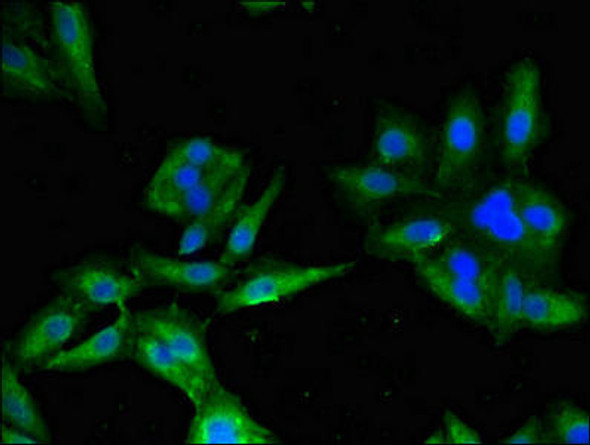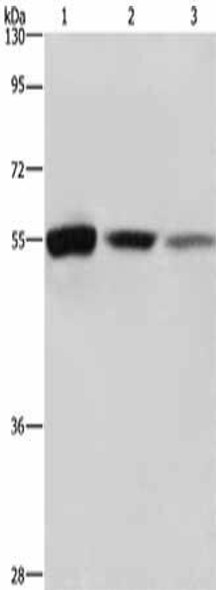Description
BLNK Antibody (PACO00469)
The BLNK Antibody (PAC00469) is a valuable tool for researchers studying B cell receptor signaling pathways. This polyclonal antibody, generated in rabbits, specifically targets the BLNK protein, which plays a crucial role in the activation of B cells. It is highly reactive with human samples and has been validated for use in Western blot applications.BLNK, also known as B cell linker protein, is essential for transmitting signals from the B cell receptor to downstream signaling molecules, ultimately leading to B cell activation and antibody production.
Dysregulation of BLNK signaling has been linked to various autoimmune diseases and B cell malignancies, making it a key target for therapeutic interventions.By utilizing the BLNK Antibody in their research, scientists can gain insights into the mechanisms underlying B cell activation and differentiation, as well as identify potential targets for novel therapies aimed at modulating immune responses. This antibody is a valuable tool for studies in immunology, oncology, and autoimmune disorders.
| Antibody Name: | BLNK Antibody |
| Antibody SKU: | PACO00469 |
| Size: | 50ug |
| Host Species: | Rabbit |
| Tested Applications: | ELISA, WB, IHC |
| Recommended Dilutions: | WB:1:500-1:2000, IHC:1:100-1:300 |
| Species Reactivity: | Human, Mouse |
| Immunogen: | synthesized peptide derived from human BLNK around the non-phosphorylation site of Y96. |
| Form: | Liquid |
| Storage Buffer: | Liquid in PBS containing 50% glycerol, 0.5% BSA and 0.02% sodium azide. |
| Purification Method: | The antibody was affinity-purified from rabbit antiserum by affinity-chromatography using epitope-specific immunogen. |
| Clonality: | Polyclonal |
| Isotype: | IgG |
| Conjugate: | Non-conjugated |
| Synonyms: | BLNK; BASH; SLP65; B-cell linker protein; B-cell adapter containing a SH2 domain protein; B-cell adapter containing a Src homology 2 domain protein; Cytoplasmic adapter protein; Src homology 2 domain-containing leukocyte protein of 65 kDa; |
| UniProt Protein Function: | BLNK: an adaptor protein that bridges the B-cell receptor-associated kinases (BCR) with a multitude of signaling pathways, regulating biologic outcomes of B-cell function and development. Plays an important role in BCR-mediated PLCG1 activation and Ca(2 ) mobilization. Does not seem to be not required for pre-BCR-mediated activation of MAP kinase and phosphatidyl-inositol 3 (PI3) kinase signaling. Plays a critical role in orchestrating the pro-B cell to pre-B cell transition. Following BCR activation, phosphorylated on tyrosine residues by SYK and LYN. When phosphorylated, serves as a scaffold to assemble downstream targets of antigen activation, including PLCG1, VAV1, GRB2 and NCK1. Its phosphorylation is required for both Ca(2 ) and MAPK signaling pathways. Defects in BLNK are the cause of hypoglobulinemia and absent B-cells.It has tumor supressor activity that is lost in many cases of childhood pre-B acute lymphoblastic leukemia (ALL). Two alternatively spliced isoforms have been described; these are differentially involved in activation and apoptosis of B lymphocytes. |
| UniProt Protein Details: | Protein type:Adaptor/scaffold Chromosomal Location of Human Ortholog: 10q23.2-q23.33 Cellular Component: cytoplasm; cytosol; plasma membrane Molecular Function:protein binding; SH3/SH2 adaptor activity; transmembrane receptor protein tyrosine kinase adaptor protein activity Biological Process: humoral immune response; inflammatory response Disease: Agammaglobulinemia 4, Autosomal Recessive |
| NCBI Summary: | This gene encodes a cytoplasmic linker or adaptor protein that plays a critical role in B cell development. This protein bridges B cell receptor-associated kinase activation with downstream signaling pathways, thereby affecting various biological functions. The phosphorylation of five tyrosine residues is necessary for this protein to nucleate distinct signaling effectors following B cell receptor activation. Mutations in this gene cause hypoglobulinemia and absent B cells, a disease in which the pro- to pre-B-cell transition is developmentally blocked. Deficiency in this protein has also been shown in some cases of pre-B acute lymphoblastic leukemia. Alternatively spliced transcript variants have been found for this gene. [provided by RefSeq, May 2012] |
| UniProt Code: | Q8WV28 |
| NCBI GenInfo Identifier: | 82592659 |
| NCBI Gene ID: | 29760 |
| NCBI Accession: | Q8WV28.2 |
| UniProt Secondary Accession: | Q8WV28,O75498, O75499, Q2MD49, |
| UniProt Related Accession: | Q8WV28 |
| Molecular Weight: | 44,451 Da |
| NCBI Full Name: | B-cell linker protein |
| NCBI Synonym Full Names: | B-cell linker |
| NCBI Official Symbol: | BLNK |
| NCBI Official Synonym Symbols: | bca; AGM4; BASH; LY57; SLP65; BLNK-S; SLP-65 |
| NCBI Protein Information: | B-cell linker protein |
| UniProt Protein Name: | B-cell linker protein |
| UniProt Synonym Protein Names: | B-cell adapter containing a SH2 domain protein; B-cell adapter containing a Src homology 2 domain protein; Cytoplasmic adapter protein; Src homology 2 domain-containing leukocyte protein of 65 kDa; SLP-65 |
| Protein Family: | B-cell linker protein |
| UniProt Gene Name: | BLNK |
| UniProt Entry Name: | BLNK_HUMAN |














